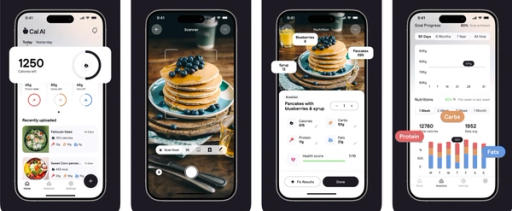
Keeping track of what you eat can feel like a job. Maybe you’ve tried to count calories, only to find that the process takes time and effort. Luckily, there’s a way to simplify this process so you can enjoy more freedom with your food. By tracking macros, especially the approach known as flexible dieting, you can enjoy a wide variety of foods and make your own rules about what works for you. This approach can help you maintain your ideal weight, fuel your body effectively, and enjoy food freedom without the stress of restrictive dieting. Does counting macros work? This article will answer this question, how to hit your macros, and address how counting macros can help you reach your health and fitness goals.
Cal AI's calorie tracker can make the process of counting macros easier. Using this tool, you can quickly and effortlessly learn how to reach your macro goals to enjoy more food freedom and less stress.

Macro counting or tracking focuses on the macronutrients in food: proteins, fats, and carbohydrates. Instead of counting calories, macro trackers figure out how much of each nutrient they eat to meet specific goals. Unlike other diets that may promote arbitrary restrictions on certain foods (or entire food groups), macro counting is flexible.
Macro counting allows you to eat various foods while working toward your goals. What’s more? Since no foods are off limits, you can still enjoy your favorite treats in moderation. The approach can help you get leaner while improving your:
The three nutrients that provide most of your energy are macronutrients:
On the other hand, micronutrients are the nutrients your body uses in smaller amounts, like:
Most foods have two or even all three different macronutrients, but they’re categorized by the most macronutrient they contain.
For instance, chicken is a protein even though it also has some fat, and sweet potatoes are considered a carb even though they have some protein. Not all macronutrients are created equal.
The quality and amount of different macronutrient groups might determine if your blood sugar falls or stays stable, if you have steady energy or are all over the place, and how much you eat at a sitting.
Those factors determine how well you can stick to your healthy eating plan. For example, here are healthy choices in every macronutrient category:
Macronutrient counting may provide several benefits.
Quality Counting macros can focus your attention on food quality rather than calorie content. For example, a bowl of sugary cereal may have a similar number of calories as a bowl of oats topped with berries and pumpkin seeds, but these meals vary widely in macronutrient content. Counting macros may lead you to choose more nutrient-dense foods to fulfill set macronutrient ranges.
Nevertheless, less nutritious foods may still count toward your macros and calories. So, it’s essential to prioritize nutrient-dense foods. May Promote Weight Loss Counting macros may be particularly effective for weight loss because they set specific dietary recommendations. For instance, tracking macros can help those following high-protein, low-carb diets linked to weight loss. Plus, research shows that tracking food intake may aid long-term weight maintenance.
Macronutrient counting is popular among athletes and those with specific health goals other than weight loss. Anyone looking to build muscle mass may have more significant protein needs than people looking to drop excess body fat. Counting macros is essential for people who consume specific macronutrients to boost performance and gain lean body mass.
For example, research shows that resistance-trained athletes may need as much as 1.4 g of protein per pound (lb) (3.1 g per kg) of body weight per day to maintain muscle mass. Counting macros may ensure that your macronutrient needs are being met.

Calculating your caloric needs is the first step to successful macro tracking. For effective macro tracking, you must first determine how many calories you should eat daily. This number differs based on age, size, activity level, and specific fitness goals.
To calculate your caloric needs, you must determine two factors:
REE refers to the number of calories a person burns at rest, while NREE indicates calories burned during activity and digestion. Adding REE and NREE gives you the total number of calories burned daily, also known as total daily energy expenditure (TDEE).
You can determine your overall calorie needs using a simple online calculator or the Mifflin-St. Jeor equation:
The result gives you your TDEE. Calories can be added or subtracted from your total expenditure to reach different goals. In other words, those trying to lose weight should consume fewer calories than they expend, while those looking to gain muscle mass should increase calories.
After determining how many calories to consume daily, the next step is to decide what macronutrient ratio works best for you. Typical macronutrient recommendations are as follows:
Keep in mind that these recommendations may not fit your specific needs. Your ratio can be fine-tuned to achieve particular objectives. For example, a person who wants to improve blood sugar control and lose excess body fat may excel on a meal plan consisting of 35% carbohydrates, 30% fat, and 35% protein.
Someone pursuing a ketogenic diet would need much more fat and fewer carbs, while an endurance athlete may need a higher carb intake. As you can see, macronutrient ratios can vary depending on dietary preferences, weight loss goals, and other factors.
Next, it’s time to start tracking your macros. tracking macros simply means logging your foods on a website, app, or food journal. The most convenient way to track macros may be through a nutrition app like:
These apps are user-friendly and specifically designed to simplify tracking macros. In addition, a digital food scale may help you track your macros, though it isn’t necessary. If you invest in one, weigh each food item you eat before logging it into your app of choice. Several apps feature a barcode scanner that automatically inputs a serving of scanned food into your macro log.
You can also hand-write macros into a physical journal. The method depends on your individual preference. Remember that it’s not necessary to hit your macro targets exactly. You can still meet your goals even if you go a few grams over or under each day.
Here’s an example of calculating macronutrients for a 2,000-calorie diet consisting of 40% carbs, 30% protein, and 30% fat:
Total grams of fat allowed per day = 600/9 = 67 g
In this scenario, your ideal daily intake would be 200 g of carbs, 150 g of protein, and 67 g of fat.
Summary
To count macros, determine your calorie and macronutrient needs, then log macros into an app or food journal.

If you are new to hearing about macros and counting macros, I understand if you are skeptical. After decades of promoting the latest fad, the diet industry has eroded our trust. Nevertheless, counting your macronutrients is a legitimate method of managing your body weight. It is derived from basic principles of nutrition and is a variation on counting calories.
Counting your macros is not a fad, and it will work to control your weight. Whether your goal is to lose weight, gain weight, or maintain, controlling the macros you consume can help. Some people may find that they can achieve more predictable weight loss than others, but it usually comes down to a person's ability to track their food accurately and adhere to their diet.
It works for the same reason that counting calories can help you lose or gain weight. The concept is energy in vs. energy out (also known as Energy Balance). Calories come from each of the macronutrients in various amounts. There are roughly four calories in each gram of protein, four in each gram of carbohydrates, and nine in each gram of fat. Nonetheless, fiber can make things tricky. Fiber is a class of carbohydrates, but some fiber types have four calories per gram, and others have 0, so a reasonable rule of thumb is to count fiber as two calories per gram instead of 4.
Sugar alcohols can also have different caloric contributions, and there is no rule of thumb for how to treat them. Luckily, sugar alcohols are seldom used, and you can Google their caloric contribution if you are curious. I will link a study of the caloric content of common sugar substitutes if you are interested. So when counting your macros, you are still counting your calories. But since they are directly related to one another, it’s convenient that you can pay attention to a target for three separate nutrients and meet your calorie goal.
If you already understand energy balance, you can skip this section.
Well, we fill the car with gasoline. The car burns small amounts of gasoline to make the engine turn over. It is essential that the vehicle takes its fuel and turns it into energy that it can use.
It has a certain amount of gas in the tank and will not extract the energy from the fuel until it needs it. Once that fuel runs out, the car will die. In the same way, we fuel our bodies with food. We extract energy from our food after it is consumed. After a while, if that energy isn’t used, we put it into our own “gas tank” (our fat stores) for future use. This is how you gain fat.
If you don’t put in enough food to sustain your activities, your body will start to get some energy from your fat stores. This is how you lose fat. Everything your body does requires energy, including involuntary organ functions like the beating. In the same way that a car shuts off when it runs out of gas, so will your body if you don’t have enough energy to sustain your life!
Macro tracking is most popular with people who do resistance training. The primary motivator is protein. When dieting, it is always possible to lose some muscle. The harder you diet and the leaner you get, the more muscle you lose. People who have spent hundreds or even thousands of hours in the gym to build muscle are interested in keeping as much muscle as possible. After all, a lot of hard work went into acquiring it.
Studies have been discussing for years how much protein is optimal for preserving muscle mass during a diet, and most conclusions tend to hover close to 0.8 grams per pound of body weight—not as high as some of the rumors you will hear around the gym. When not dieting, people who count their macros aim to get enough protein to support optimal muscle growth and eat enough calories to maintain or increase their body weight. In both cases, setting an upper limit on fats can help you eat more volume of food while staying within your calorie limit (This may help you feel full).
Fat-rich foods are much more calorie-dense since fat has more than twice the caloric content of the other two macronutrients. These are all great reasons to count your macros, but there are things you need to consider when eating healthily while following a macro-based diet. After all, there are many more nutrients than protein, fat, and carbs.
People tend to emphasize too much the question, “How much (insert nutrient) do I need to eat daily?” Macro tracking sometimes leads to people focusing on hitting their macros right on the mark at the expense of all other healthy diet practices.
Your body doesn’t operate on 24 deadlines. If you are 10g short on your daily fat goal when 9 pm rolls around, do not eat 2 tsp of oil to hit your macros. It will not help you achieve anything. Your body has various methods of stockpiling essential nutrients, and your body won't get rid of these stores at midnight. The macro targets you are trying to satisfy were not developed in a laboratory; they are just guidelines. Provided your calories are close to your target amount, you will see the weight changes you seek.
Nutrition labels can contain significant errors. So don’t stress yourself out about achieving perfect numbers. Legally speaking, the calories in a food item can be up to 120% of the value reported on the Nutrition Label. Your tracking is likely not as accurate as you would like it to be. But this doesn’t mean you should give up. It helps to try to be as precise as possible.
Keeping track of your nutrients is currently the best solution we have. And it works despite some inaccuracies!
People often default to choosing foods high in only one of the three macronutrients, such as essential carb foods, lean meats, and high-fat foods. This can make hitting your macros relatively easy. A large serving of lean meat will help if I am low on protein. If I am low on fat, a handful of nuts will do… You get the idea.
It is tough to figure out how to pair everyday foods to hit specific macronutrient targets, so people only use foods high in a single macronutrient. This leads to people eating boring plates of chicken, rice, and steamed broccoli multiple times daily, sometimes even forgetting vegetables, as they don’t contribute many macronutrients.
A monotonous diet can make hitting your macro targets easy, but it is doubtful that it contains all the other essential nutrients for your health. This is NOT healthy eating. A healthy diet has many more dimensions: eating lots of fruits and vegetables, getting enough fiber, watching my saturated fat intake, etc.
Obsessing over macronutrient targets could easily be argued to be disordered eating, especially when it becomes the sole focus of someone’s nutritional habits. While not a clinical diagnosis, Orthorexia Nervosa is an eating disorder that involves an obsession with healthy eating.
This obsession is advanced enough that it has an overall negative effect on the well-being of the person experiencing it. The purpose of a macronutrient-based diet is to improve the calorie-counting method. Ideally, your goal was to become healthier.

Cal AI transforms calorie tracking with cutting-edge AI technology. Just snap a photo of your meal, and we'll do the rest. Our app combines your phone's depth sensor with advanced AI models to analyze food volume, identify ingredients, and instantly calculate calories, protein, carbs, and fat content.
With 90% accuracy on visible foods and multiple tracking options like barcode scanning, food label recognition, and manual description for complex items like smoothies, we've made nutrition tracking effortless. Gone are the days of tedious manual logging calorie tracking apps.
Whether scanning a full meal or a quick snack, Cal AI gives you accurate nutritional information in under 15 seconds. Plus, our AI learns from your feedback, continuously improving its accuracy. Stay on track with personalized insights and brilliant reminders. Cal AI makes achieving your fitness goals simpler than ever.
Track your calories with your camera with Cal AI's AI calorie tracker today!